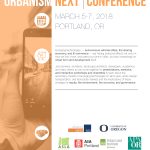Proposals for presentations, panels and workshop/charrettes for the National Urbanism Next Conference are due on Nov. 6th. Get yours in!
See details about the conference and the call for proposals here.
Proposals for presentations, panels and workshop/charrettes for the National Urbanism Next Conference are due on Nov. 6th. Get yours in!
See details about the conference and the call for proposals here.
We have often discussed on this blog that one of the key disruptions of emerging technologies will be land values.
As AVs and ride-sharing becomes more prevalent we will tend to have an increase in land supply (reduced parking needs will free up land used for parking – today’s largest single land use in most US cities, while increased ease of travel will expand metropolitan footprints and land at the periphery will now become viable for development). As E-Commerce continues to grow we will continue to see store closings and a reduction of commercial development – already being felt today – and hence an increase in available land supply. Basic economic theory tells us that if we end up increasing land supply – both in central cities and in the periphery – land values should go down.
With this, the question is how much of an impact will this reduction in land values have on overall property values – or ‘how much of my property’s value is the land and how much is the building?’. A recent analysis by Issi Romem tackles this question by plotting the building replacement value and land value in major metro areas throughout the country.
The findings are sobering. In growing coastal cities, the land value is more than 3.5 times the building replacement value and the vast majority of properties in these metro areas having the land value exceed the building replacement value. What this means is that changes to land values will drastically alter overall project values. If the impacts we describe above come to fruition, we will see large disruptions to overall real estate value throughout the country. Take a look at the article to see maps of different metro areas to see how this differentiates itself within metro areas. Not surprisingly, the areas closest in are the most affected – and by factors of up to 5 times the home replacement value.
This could be a boon for the affordability of housing – especially in areas closer into central cities where accessibility to jobs and services is easiest (under current transportation systems…), but it will be a large disrupter in the overall real estate market and could put many current homeowners underwater.
Urbanism Next researchers are always thinking about how emerging technologies are shaping our cities, but we didn’t anticipate that a technology company would literally design a neighborhood. But that is what Alphabet (Google’s parent company) proposes to do. The New York Times reported today that Sidewalk Labs, a subsidiary of Alphabet, is partnering on an 800-acre development proposal to fully integrate technology into the new neighborhood and to create, “the world’s first neighborhood built from the internet up.” It remains to be seen how the integration of technology will be accepted by the people that live in the neighborhood. Stay tuned.
“By 2030, within 10 years of regulatory approval of fully autonomous vehicles, 95% of all U.S. passenger miles will be served by transport-as-a-service (TaaS) providers who will own and operate fleets of autonomous electric vehicles providing passengers with higher levels of service, faster rides and vastly increased safety at a cost up to 10 times cheaper than today’s individually owned (IO) vehicles.”
This is the startling start to a substantive new report by RethinkX, a research group that looks at disruptive technologies from a finance, market, and technology perspective. As bold and clear as that opening sentence is, this report goes on to describe the possible impacts on everything from the geopolitical implications of a crashing oil economy to the boost of household income (10%) due to reduced transportation costs to the changes in the automobile industry from production to the local repair shop. They predict a reduction in automobile in use from 247 million vehicles to 44 in an extremely short time frame, all the while estimating that actual miles that people will travel will double compared to a 2021 estimate and at a quarter of the cost.
How those shifts impact the form and function of cities, employment, land use, social cohesion, municipal budgets, etc. are not the subject of this report. Nor is there a discussion about the non-auto forms of transportation in the future, how street space might be re-allocated, where and how urban form and place-making change, or the policy environment that influences all of these local qualities. However, understanding possible changes due to accelerating feedback loops of AV technology and rollout, as well as industry and resource disruption globally and industry-wide, makes this report a very clear contributor to understanding that AVs are not a transportation issue, they are an everything issue.

Advances in technology such as the advent of autonomous vehicles (AVs), the rise of E-commerce, and the proliferation of the sharing economy are having profound effects not only on how we live, move, and spend our time in cities, but also increasingly on urban form and development. While there has been a focused effort on research around the technological aspects of AVs, there has been a shortage of systematic exploration of the secondary effects on city development, form, and design, and the implications for sustainability, resiliency, equity, cost, and general livability. The Sustainable Cities Initiative at the University of Oregon has partnered with the National and Oregon Chapters of the American Planning Association, the American Institute of Architects, the American Society of Landscape Architects, and the Urban Land Institute to build a national network of thought leaders from the private sector, public sector, and academia to address these topics.

With this goal in mind, we are bringing leaders from around the country to Portland, OR to partake in the first annual Urbanism Next Conference. This conference will bring together a truly interdisciplinary group of people from the private, public and academic sectors who play a critical role in the future of our cities. The conference will explore five major themes of how technology related to AVs, the sharing economy, and E-commerce will change our communities: Land Use, Urban Design, Transportation, Real Estate, and Policy and Finance.
Watch this site for registration information and call for sessions and workshops/charrettes.
While GM and Tesla may continue to feud publically about whether or not Teslas are already level 4 or 5 AVs, Waymo/Google is claiming to be MONTHS!! away from starting a taxi service in the Phoenix area. The reports indicate it “ is likely to launch first in Chandler” where Waymo has been testing their vehicles. The choice of Chandler and Arizona as the testing ground are no accident. The wide streets, few pedestrians, and fewer regulatory hurdles have made this a prime test spot for what many expect to be the future of transportation.
While Arizona law currently relies upon a human to be able to be in charge of the vehicle, Waymo appears to be working around this requirement to have a driver by having a human ‘on call’ remotely that is able to monitor the vehicles to respond when things get “sticky.” The push right now by Google execs is to get the Waymo taxi rolling in 2017, but given how far ahead Waymo appears to be compared to their rivals, slipping the start date to early 2018 probably won’t take away the ‘first to AV’ title.
Robin Chase has led an effort to create a set of Shared Use Mobility Principles that can serve as a guide for communities everywhere. A key aspect of these principles (and one often advocated by this blog) is that the goal is not to simply accommodate these emerging technologies, but that we should all start with community goals and these technologies should be leveraged to achieve those goals.
For cities just starting to look at strategies and approaches to emerging transportation technologies, this – and Seattle’s New Mobility Playbook – are great places to start.
AVs have real potential to provide easier and more convenient transportation options for people. They have the potential to provide seniors and the disabled access to the world outside of their homes in ways that are now often too expensive to widely adopt. The cost for paratransit, provided by public transit systems, is quite expensive. The Government Accountability Office (GAO) reports that ADA compliant paratransit costs an average of $29.30 per trip in 2010, this is “an estimated three and a half times more expensive than the average cost of $8.15 to provide a fixed-route trip.” And the GAO additionally reports that the cost of paratransit increased by 10% from 2007 to 2010. Consequently, ADA paratransit has the potential to greatly benefit from AVs—which we presume will have substantially lower operating expenses. In the current model of public transit operating expenses are roughly twice that of the capital expenses. And while operating expenses are likely to drop dramatically if we no longer need drivers for paratransit, there still may be a need for assistance on-board AVs that are ADA compliant and utilized for paratransit—but this is an open question.
Some discussions we’ve had in our workshops over the last 9 months circle back to when elevators switched from being operated by a human in the elevator, to when they were automated. For about 20 years, so I’ve been told, buildings with elevators continued to staff elevators because people were not comfortable riding an elevator without an operator. Today it seems sort of creepy (most of the time) to have an elevator operator—though some places like the Space Needle in Seattle have an operator, this is less about needing someone to operate the actual elevator and more about the experience. Some of the concerns that have arisen in our discussions of AV busses generally is that the bus drivers provide more services to riders than just driving. They assist riders get to where they need to go. They provide a sense of safety to the riders that there is a public employee looking out for them. The general sense that we have gotten from most people we are talking to is that we will likely need to have employees on AV fixed route buses to act as guides, babysitters, and general monitors to provide riders with a sense of comfort on the busses. It is easy to imagine a woman or child (or anyone really) riding a bus getting scared when a creepy person approaches them—the bus driver (now) or transit employee (in the AV) can help provide a buffer between creepy folks and the rest of us.
While AVs have the potential to enhance public transit by providing more efficient fixed route and paratransit services, AVs also have the potential to decimate demand for public transit. Transit systems, bus ridership in particular, are already seeing declines in ridership because of the TNCs (Uber/Lyft)— “Compared to other public transit options, buses are used more for short trips—the kind of trips that ride-hailing companies like Uber and Lyft tend to make.” The utilization of TNCs for shorter trips need to be part of our planning for transit in the long-run with the increasing presence of AVs or we will have to subsidize all riders on public transit even more. Change is coming…change is already here.